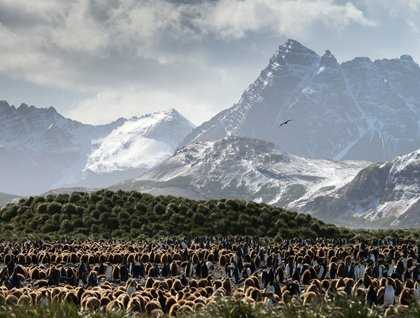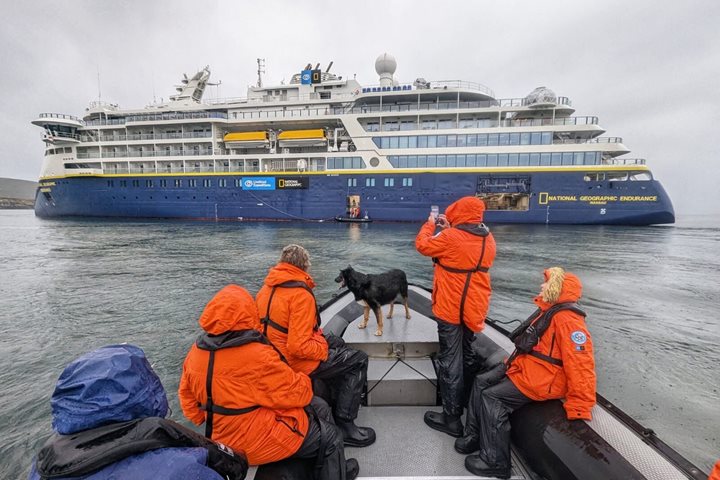Today, dreams became a reality. For some, their dream was to someday return to the island of South Georgia, where memories of glaciers, mountains, and densely packed beaches teeming with seals and penguins have been seared into their minds since the last visit. For others, a chance to step on soil shared by Sir Ernest Shackleton and his men, exactly 100 years ago, or navigate large swaths of the Southern Ocean were dreams that, today, and in the days to come, have been realized.
Our first glimpse of this 100-mile-long, northwest- to southeast-oriented island was early this morning as its rugged skyline began to emerge through low cloud cover. Hoping for a favorable wind that would allow us to land, we slowly approached a beach known as Salisbury Plain, located in the northeast region of South Georgia. With luck on our side the winds cooperated perfectly, allowing for a very manageable swell with which to access this long, expose stretch of beach. Before even making landfall the sound of 60,000 king penguins, accompanied by thousands of fur and elephant seal bellows greeted our arrival. Through an early dusting of snow and winds the skies opened up, exposing a huge, flat expanse, back-dropped by 6,000 to 7,000 foot, snowcapped mountains and large, icy rivers pouring down from the heights. In the foreground was an overwhelming mass of king penguins in various stages of maturity. Eight to 10-month-old, brown, downy chicks were clustered together in groups known as crèches, while beautifully plumaged adults we incorporated either in the main colony, or sitting quietly in small groups around the periphery, undergoing the slow, no doubt annoying, annual molt.
With puffy white clouds offset by the brilliance of a clean, blue sky, patches of green tussock grass to frame the colony, and thousands of tiny orange ocular patches of color, so distinctive of mature king penguins, the morning’s scene became a most effective dream catcher.
The afternoon led us a few miles east to a small speck of rock called Prion Island. Despite the name it is most well known for the numerous wandering albatrosses, which frequent its upper slopes. Accessed by a small beach on the lee side of the island, a short boardwalk leads small groups up to the nest sites. Today, however, we encountered some obstacles. With the staggering comeback of the fur seal populations around South Georgia (only a few decades back they were feared extinct due to a heavy toll from hunting) this species has exploded to the point that we could not even get ashore today. With the small landing beach on Prion Island, and a spreading seal population, there is less and less room for territorial males to set up shop. And, the space they do find, they are not going to give up easily. After a nerve-racking attempt by staff to simply make it to the boardwalk (50 feet from the landing) we conceded to the fur seals, and opted for the much safer view of the island from our Zodiacs. Lichen-encrusted coves, soaring light-mantled Albatross pairs, and even close looks at our planet’s southernmost song bird, the South Georgia pipit, made for a fantastic alternative to our landing ashore.
Today, South Georgia showed a multitude of personalities. The same place that makes dreams come true can also put them to rest. While our looks at nesting albatross may have been thwarted we could not have asked for a better landing at Salisbury Plain. This is just our first day in a dynamic place with many dreamscapes to come.







